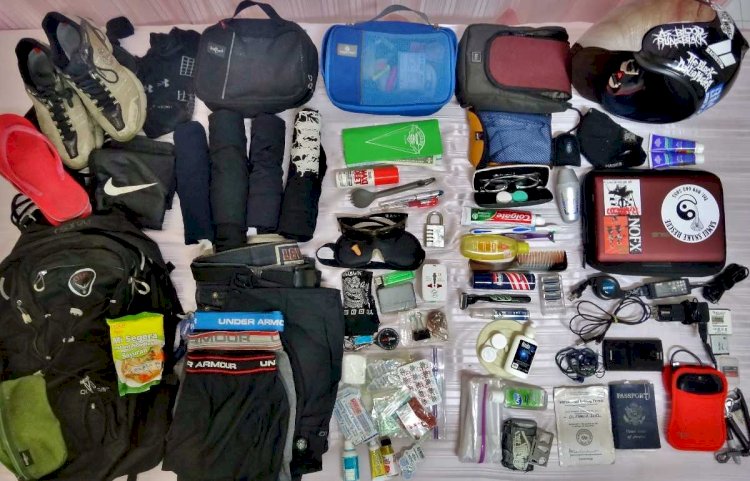The Thing You Must Take On A Trekking Trip

Embarking on a trekking trip is an exciting adventure that allows you to connect with nature and challenge your physical limits. However, to make the most of this outdoor experience, it's crucial to be well-prepared and equipped with the right gear. Trekking in remote and rugged landscapes demands careful consideration of essential items to ensure your safety, comfort, and enjoyment throughout the journey. Here are the must-know things about trekking trips:
A. Definition of Trekking:
Trekking is an adventurous outdoor activity that involves exploring natural landscapes on foot, typically in remote or mountainous regions. It goes beyond regular hiking, often covering more challenging and extended routes. Trekkers immerse themselves in the beauty of nature, encountering diverse terrains and breathtaking views along the way.

B. Growing Popularity of Trekking Trips:
In recent times, trekking trips have experienced a surge in popularity among adventure enthusiasts and nature lovers alike. It offers a unique opportunity to disconnect from the digital world, rejuvenate the mind and body, and create lasting memories in the lap of nature.
C. Importance of Being Prepared:
While trekking offers unforgettable experiences, being prepared is essential for a safe and successful journey. Trekking often takes place in remote areas, away from immediate assistance and amenities. Proper preparation ensures you have the right gear, knowledge, and skills to tackle potential challenges, varying weather conditions, and unpredictable terrains. It allows you to fully relish the trekking adventure while minimizing risks and maximizing enjoyment.

Essential Trekking Gear:
·Proper Footwear:
Investing in the right footwear is paramount for a successful trekking trip. Sturdy and comfortable hiking boots or trekking shoes with good ankle support will protect your feet during long walks over uneven terrain. Make sure to break in your footwear before the trek to avoid blisters and discomfort.
·Comfortable Clothing Layers:
Dressing in comfortable and moisture-wicking clothing layers is essential for trekking. Opt for lightweight and breathable base layers to wick sweat away from your body. Insulating mid-layers, such as fleece or down jackets, provide warmth in cooler climates. Waterproof and windproof outer shells are crucial to protect against rain and strong winds.

·Backpack and Rain Cover:
Choose a well-fitted and durable backpack to carry your essentials during the trek. Look for a pack with padded shoulder straps and a hip belt to distribute weight evenly. Don't forget a rain cover to shield your backpack and belongings from unexpected downpours.
·Trekking Poles:
Trekking poles offer invaluable support and stability while traversing challenging terrains. They reduce strain on your knees and legs during steep ascents and descents. Collapsible and lightweight poles are easy to carry and can be adjusted to your preferred height.
·Headlamp or Flashlight:
A reliable headlamp or flashlight is a must for any trekking trip, especially if you plan to hike during early morning or evening hours. It ensures visibility in low-light conditions and allows you to navigate safely, even in the dark.
With the right trekking gear, you'll be well-prepared to take on the trails, embrace the natural beauty, and enjoy the journey to the fullest.

Safety and Navigation Tools:
·First Aid Kit and Personal Medications:
A well-stocked first aid kit is a non-negotiable essential for any trekking adventure. Include bandages, antiseptic ointment, adhesive tape, pain relievers, blister pads, and any specific medications you might need. Carry personal medications and prescriptions, and inform your trekking companions of any allergies or medical conditions.
·Navigation Equipment: Map, Compass, GPS Device:
Navigating through unfamiliar terrains requires reliable tools. Bring a detailed map of the trekking route and a compass to help orient yourself. A GPS device or smartphone with offline maps is an additional navigational aid, but remember to conserve battery life and have a backup plan.

· Water Purification System:
Access to clean water is crucial during a trek. Carry a water purification system, such as water purification tablets or a portable water filter, to treat water from natural sources and ensure it's safe for consumption.
Prioritizing safety and having reliable navigation tools will give you the confidence to tackle the trek and handle unexpected situations that may arise. These precautions ensure a secure and enjoyable trekking experience, allowing you to focus on exploring the beauty of the great outdoors.
Shelter and sleeping equipment:
Shelter and a good night's sleep are crucial aspects of a successful trekking trip. Here's what you need for your shelter and sleeping equipment:
·Tent and Sleeping Bag Selection:
Choose a lightweight and weather-resistant tent that suits the size of your trekking group. Look for tents with easy setups and durable materials to withstand varying conditions. A high-quality sleeping bag rated for the expected temperature range of your trekking destination is essential to keep you warm and comfortable during chilly nights.

·Sleeping Pad or Mat for Insulation:
A comfortable and insulated sleeping pad or mat is essential to provide cushioning and insulation from the cold ground. Look for inflatable or foam pads that offer sufficient support and can be easily packed in your backpack.
·Lightweight Camping Stove and Cookware:
A compact and lightweight camping stove is ideal for preparing hot meals and beverages during the trek. Choose a stove that runs on easily available fuel and is easy to use. Additionally, pack lightweight cookware, such as a pot, pan, and utensils, to make cooking efficient and convenient.
Having the right shelter and sleeping equipment ensures that you rest well after a day of trekking, helping you stay energized and ready for new adventures each day. Make sure to invest in quality gear that suits the specific demands of your trekking trip for a comfortable and memorable experience.

Conclusion:
By thoroughly preparing and equipping yourself with the right gear, you'll be ready to embrace the beauty of the great outdoors and fully immerse yourself in the trekking experience. Remember to respect nature, follow Leave No Trace principles, and always stay mindful of the environment around you.
So, whether you're a seasoned trekker or embarking on your first trekking trip, take the time to prepare, plan, and pack accordingly. Be open to new experiences, connect with fellow trekkers, and savor every moment of your journey. With the right gear and a sense of adventure, your trekking trip will be an unforgettable and transformative experience. Set forth on your next trekking adventure, and let the trails lead you to extraordinary destinations!






































